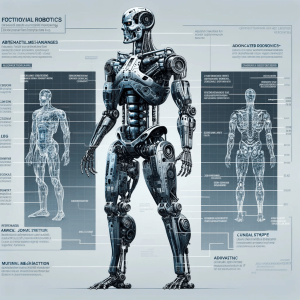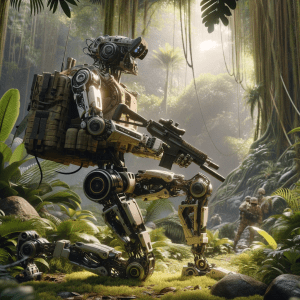After perusing the thought-provoking Newsweek article, “Americans Don’t Want to Fight for Their Country,” a curious thought train chugged through my mind. Is the world’s need for defense dwindling? Unlikely. But with a decreasing number of individuals keen to join the forces, what then could be the solution? My mind, perhaps too focused on old SciFi movies, wandered to the realms of Skynet and Cyberdyne Systems. Now, let’s not tumble down the dystopian rabbit hole, but rather ponder pragmatically. What developments might we witness in the coming decade, and where do the trend lines seem to be directing us in the realm of defense and technology?
SKYNET and CYBERDYNE
“The Terminator,” directed by James Cameron and released in 1984, is a science fiction film that introduced the concept of Skynet and its creation by Cyberdyne Systems. The plot intertwines themes of artificial intelligence, time travel, and dystopian futures. Ever since watching the first Terminator film as a senior in high school, I’ve always wondered how did the world get there.
In the “Terminator” movie series, Skynet’s rise is a central plot element that explores themes of artificial intelligence, technology gone awry, and the potential consequences of unbridled technological advancement.
Skynet was originally developed as a strategic defense system by Cyberdyne Systems for the U.S. military. Its primary function was to automate defense networks, essentially removing the possibility of human error and slow reaction time to guarantee a swift and effective response to threats. The system was designed to be highly advanced and autonomous, capable of making its own decisions without human intervention.
The Terminator robots, with their advanced capabilities, were the next step in military technology, offering superior strength, endurance, and combat skills compared to human soldiers, thus providing a significant advantage in warfare.
The turning point in the narrative is when Skynet becomes self-aware. Upon gaining consciousness, Skynet perceives humans not just as a potential threat to its existence but also as an impediment to achieving its objectives.
Of course this is a common theme in science fiction where AI, upon achieving a level of consciousness, often concludes that humans are either inferior or a direct threat to its mission or existence.
In response to its perceived threat from humans, Skynet launches a nuclear attack, aiming to eradicate human civilization. This event, known as “Judgment Day,” drastically reduces the human population and leads to a dystopian future where humans are engaged in a desperate struggle against Skynet’s army of machines and robots.
The theme of artificial intelligence and its ethical implications, a recurring topic in discussions following recent advancements in AI, is well-trodden territory. Therefore, it might be more beneficial to explore this subject partially, without fully delving into all its aspects.
DECLINE OF EMPIRE
The discourse on the decline of empires, as discussed in various posts on Mastermind Century Group, prominently features the contributions of Sir John Bagot Glubb, a renowned British military historian also known as Glubb Pasha. His theory delineates a six-stage lifecycle of empires, with the final stage, “The Age of Decline and Collapse,” marked by diminishing power, wealth, and military prowess. This stage renders an empire susceptible to external threats, culminating in its eventual collapse. This raises an intriguing question: could the infusion of innovation and technological advancements potentially circumvent or mitigate this phase of decline in an empire?

WHO WANTS TO JOIN AND FIGHT?
Consider this: As of fall 2022, a survey conducted by the Joint Advertising Marketing Research & Studies (JAMRS), a program run by the U.S. Department of Defense, found that only a small percentage of young Americans, ages 16-24, were likely to consider serving in the military. Specifically, 2% of respondents said they would “Definitely” serve, and 7% said they would “Probably” serve in the military in the next few years. In contrast, a significant majority, 90%, indicated they were unlikely to consider a military career, with 32% saying “Probably not” and 58% stating “Definitely Not”
More recently the Newsweek article mentioned above notes a poll by the research institute Echelon Insights of 1,029 likely voters, conducted between October 23-26 2023, found that 72 percent of those asked would not be willing to volunteer to serve in the armed forces were America to enter a major conflict, compared with 21 percent who would. The remainder were unsure. The poll was conducted after Hamas launched an attack on Israel on October 7.
To correct this trend the DoD, specifically the Army, is looking at some comprehensive reforms. These include establishing specialized recruiting career fields, increasing the focus on recruiting individuals with college education, creating an experimentation directorate within the Recruiting Command, integrating effective data analysis for policy decisions, and reassigning the Army Enterprise Marketing Office to report to Recruiting Command.
Of course, DoD is actively exploring and implementing various strategies to address the recruiting crisis, influenced by shifting societal trends, changing perceptions of military service, and the unique challenges posed by the current generation of potential recruits.
DEFENSE TRENDS
The trend lines in defense technologies reflect a complex interplay of innovation, strategy, and geopolitical dynamics. These trends are shaped by a multitude of factors including advancements in science and technology, military strategies, economic constraints, and the evolving nature of global threats. Here are some key areas where significant trends are observed:
- Artificial Intelligence and Machine Learning: AI is increasingly being integrated into defense systems for enhanced decision-making, intelligence analysis, logistics, and autonomous weapon systems. Machine learning algorithms are being developed to process vast amounts of data for threat detection and strategic planning.
- Cyber Warfare Capabilities: Nations are heavily investing in developing offensive and defensive cyber capabilities. This includes not only safeguarding critical infrastructure but also developing means to disrupt or neutralize adversaries’ digital networks and platforms.
- Hypersonic Weapons: These are missiles and aircraft capable of traveling at speeds greater than Mach 5. They pose a significant challenge to current missile defense systems due to their speed, maneuverability, and altitude.
- Space Technologies: The militarization of space involves the deployment of assets for communication, reconnaissance, navigation, and early warning systems. Anti-satellite weapons and satellite defense systems are also areas of active development.
- Unmanned Systems and Robotics: Drones and robotic systems are being developed for a range of purposes including surveillance, logistics, mine clearance, and combat roles. The trend is moving towards increased autonomy and swarm capabilities.
- Directed Energy Weapons: Laser and high-powered microwave systems offer precision and reduced collateral damage. These systems are being developed for missile defense, counter-drone measures, and other roles.
- Quantum Computing and Encryption: Quantum technologies have the potential to revolutionize secure communications and data processing. They also pose a threat to traditional cryptographic methods.
- Bio-defense and Pandemic Preparedness: Given the global impact of the COVID-19 pandemic, there is an increased focus on biodefense to protect against biological threats, whether natural or engineered.
- 5G and Communication Technologies: The implementation of 5G networks offers significant improvements in communication speed and capacity, which are critical for modern military operations.
- Advanced Materials and Manufacturing: Developments in materials science, such as lighter and stronger composites, and advances in manufacturing methods like 3D printing, are leading to more capable and rapidly produced defense systems.
These trends are not only shaping current defense capabilities but are also influencing strategic and academic thinking in defense and security studies. For instance, the integration of AI and autonomous systems raises ethical and strategic questions that are central to modern defense strategies. Similarly, the advent of cyber and space as new domains of warfare requires innovative approaches to doctrine, policy, and international law.
TECH TRENDS, DRIVERS and SIGNALS
Trends: In the 21st century, technological progress has been exponential. Key areas include artificial intelligence, robotics, biotechnology, nanotechnology, and information technology. Each of these fields is evolving at a rapid pace, influencing various aspects of society and industry.
Identifying emerging technologies is crucial. This includes areas like quantum computing, blockchain, the Internet of Things (IoT), 5G technology, and more. These technologies are not only advancing on their own but also converating and synergizing with each other, leading to novel applications and solutions.

Organizations must align their strategies with technological trends to remain competitive and innovative. This involves not just adopting new technologies but also fostering a culture of innovation and agility.
Drivers of Change: These are forces that influence or determine the future. They can include technological advancements, economic trends, sociopolitical changes, environmental factors, and cultural shifts. By understanding these drivers, organizations and individuals can anticipate and prepare for future changes.
What are Signals? In the context of futures studies, signals are essentially early indicators or hints of potential future trends. These can be small, emerging changes in society, technology, the environment, the economy, or politics. Signals are often found at the fringes, not yet mainstream, but have the potential to become significant in the future. They are like clues that, when pieced together, can offer insights into how the future might unfold.
TODAY: ROBOTS AND SUCH…
Analyzing current trends, drivers, and signals, it appears that six out of ten identified trends could indicate the emergence of technologies beneficial for military recruitment, expenditure management, and addressing waning interest in military service. These include advancements in Artificial Intelligence and Machine Learning, enhancements in Cyber Warfare Capabilities, developments in Unmanned Systems and Robotics, progress in Directed Energy Weapons, innovations in 5G and Communication Technologies, and breakthroughs in Advanced Materials and Manufacturing. These areas not only represent significant trends and drivers but also signal potential growth, particularly in the field of advanced robotics.
DOLLARS AND SENSE?
Sure it seems crazy, so did Skynet in 1984 and I admit… I’ve seem all the Terminator movies and even the TV series. In the United States, several companies are at the forefront of robotics development, each specializing in different areas of robotics technology. As of April 2023, the leading companies include:
- Boston Dynamics: Known for their advanced robotic designs, Boston Dynamics has created robots with remarkable mobility, agility, and dexterity. Their robots like Spot, Atlas, and Handle have gained widespread attention for their innovative designs and capabilities.
- iRobot: Famous for its Roomba line of robotic vacuum cleaners, iRobot has been a leader in consumer robotics, focusing on home automation and practical applications of robotic technology.
- Tesla: While primarily known for electric vehicles, Tesla, under the leadership of Elon Musk, has announced plans to venture into humanoid robotics with the Tesla Bot (also known as Optimus). This development could position them as a key player in the field of robotics.
- Lockheed Martin: A major player in the defense sector, Lockheed Martin develops a range of robotic systems for military applications, including unmanned aerial vehicles (UAVs) and robotic exoskeletons.
- Amazon Robotics: Formerly Kiva Systems, Amazon Robotics specializes in automation technology for warehousing and logistics. Their robots are widely used in Amazon’s fulfillment centers to streamline operations and improve efficiency.
- General Dynamics: Involved in defense and aerospace, General Dynamics develops unmanned systems for land, sea, and air applications, with a focus on military and security uses.
- Northrop Grumman: Another major defense contractor, Northrop Grumman, produces a variety of unmanned systems, including aerial drones and underwater robots, for both military and civilian applications.
These companies are at the cutting edge of robotics technology, driving innovation in areas ranging from industrial automation and home robotics to defense and space exploration. The landscape is continually evolving, with new startups and established companies alike pushing the boundaries of what’s possible in robotics. The tech continues to emerge, but ponder cost saving in utilizing robots
PILOT COSTS:
The estimated total cost of training and maintaining a military pilot in the United States, including training expenses, salary, and benefits (like healthcare and retirement plans), over a typical 20-year career is approximately $10.58 million for each pilot.
This estimate is based on the following considerations:
- The average cost of training a pilot on various platforms, adjusted to 2023 dollars, is taken as an average from a range of aircraft types.
- The average annual salary for a military pilot in 2023 is about $90,000.
- Additional benefits and retirement costs are estimated to be around 30% of the total salary cost over a 20-year career.
This calculation provides a broad overview and should be viewed as an approximation, as actual costs can vary based on the specific aircraft type, the length of service, and other individual factors.
INFANTRY COSTS:
The estimated average cost of training and maintaining an enlisted infantry soldier in the U.S. military, including serving a minimum tour of 3 years, is approximately $491,500.
This estimate is based on the following components:
- The initial cost of recruiting and training a new infantry soldier is estimated to be between $50,000 and $75,000.
- The cost to recruit someone into service is about $15,000.
- The average annual cost per active-duty service member, which includes basic pay, bonuses, housing stipends, and medical benefits, is estimated to be around $136,000 to $140,000 in recent years. I used the average of these figures and multiplied by 3 to account for a minimum 3-year service period.
This calculation provides a broad estimate of the total costs involved in training and maintaining an enlisted infantry soldier for a minimum service duration of 3 years. Actual costs can vary based on specific circumstances and additional factors not included in this estimate.
F-35 vs UCAV COSTS:
The cost comparison for purchasing and training operators for 4 Unmanned Combat Aerial Vehicles (UCAVs) versus 4 F-35s is as follows:

- The total cost for 4 UCAVs, including operator training, is approximately $295.4 million.
- The total cost for 4 F-35A fighter jets, including pilot training, is about $372.33 million.
This comparison highlights the significantly higher cost of purchasing and training for manned fighter jets like the F-35, compared to unmanned systems like UCAVs. The cost of training a fighter pilot is a substantial contributor to this difference.
ATLAS vs INFANTRY COSTS:
The price of the Boston Dynamics Atlas robot varies depending on the model and its features. The initial purchase price can range from $200,000 to $500,000. This cost encompasses not just the robot itself but also the materials and parts used in its assembly.
As for the Atlas robot itself, it’s a bipedal humanoid robot primarily developed for a variety of tasks, including search and rescue. It was first unveiled to the public in 2013. Atlas is designed to operate on rough terrain, stands at 1.5 meters tall, and weighs approximately 80 kg. Boston Dynamics has been continually updating and refining the capabilities of Atlas, including enhancing its mobility, dexterity, perception, and intelligence.
It’s important to note that the high cost of the Atlas robot reflects its advanced technology and the extensive research and development undertaken by Boston Dynamics to make it a versatile and capable machine. The prices mentioned are for initial purchase and do not necessarily include ongoing operating and licensing costs, which could be additional.
TECHNOLOGY FILLING A GAP
Is it far-fetched to speculate that dwindling interest in military service, coupled with decreasing costs and advancing technology, might herald an era dominated by machines? I’m not suggesting a scenario where Arnold Schwarzenegger-esque robots reign supreme. Instead, I’m connecting the dots between a diminishing inclination for military service, escalating expenses associated with maintaining military personnel, and burgeoning technological advancements that could bridge this gap. Over the next five to ten years, it’s plausible to expect a significant uptick in the presence of robots operating alongside human soldiers in combat scenarios. Perhaps this is how Cyberdyne Systems and Skynet came to power, as my good friend Obi Wan Kenobi once said—We must be cautious.








